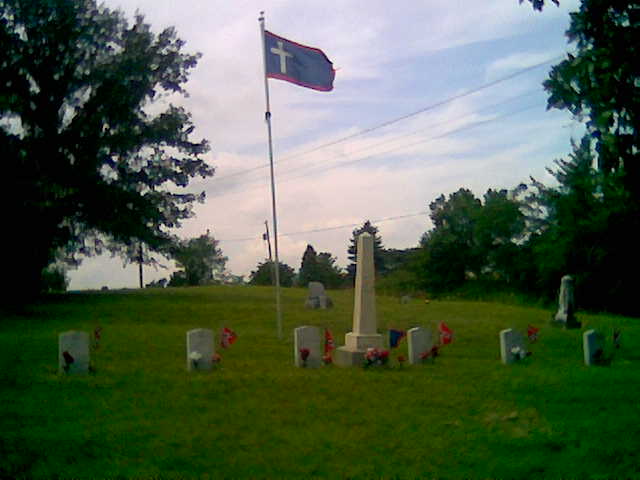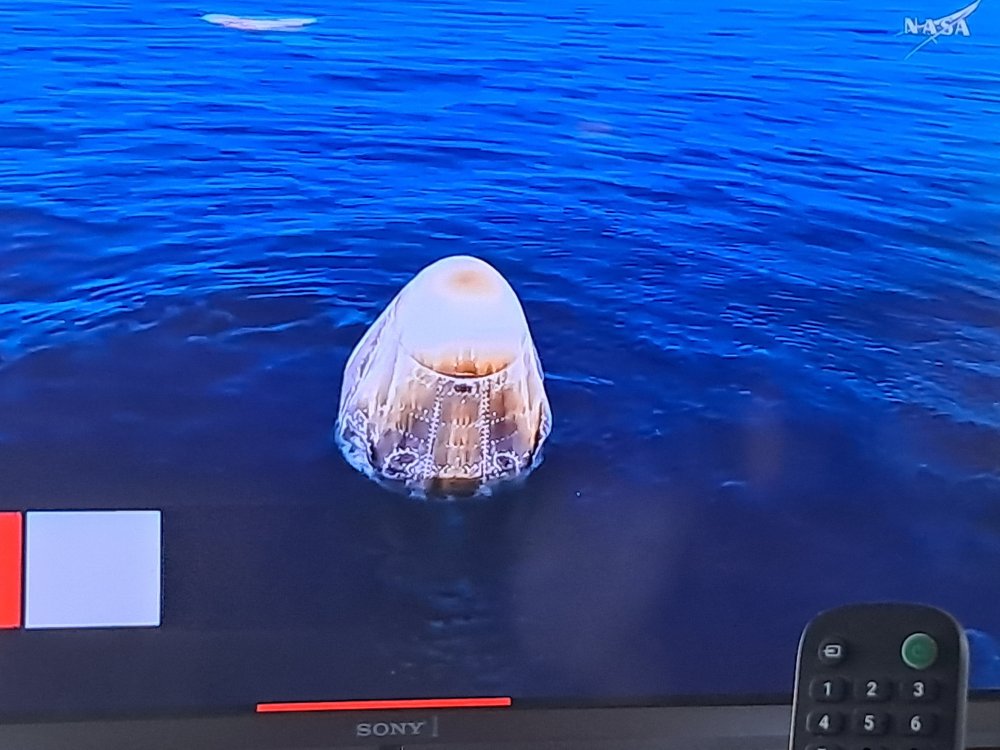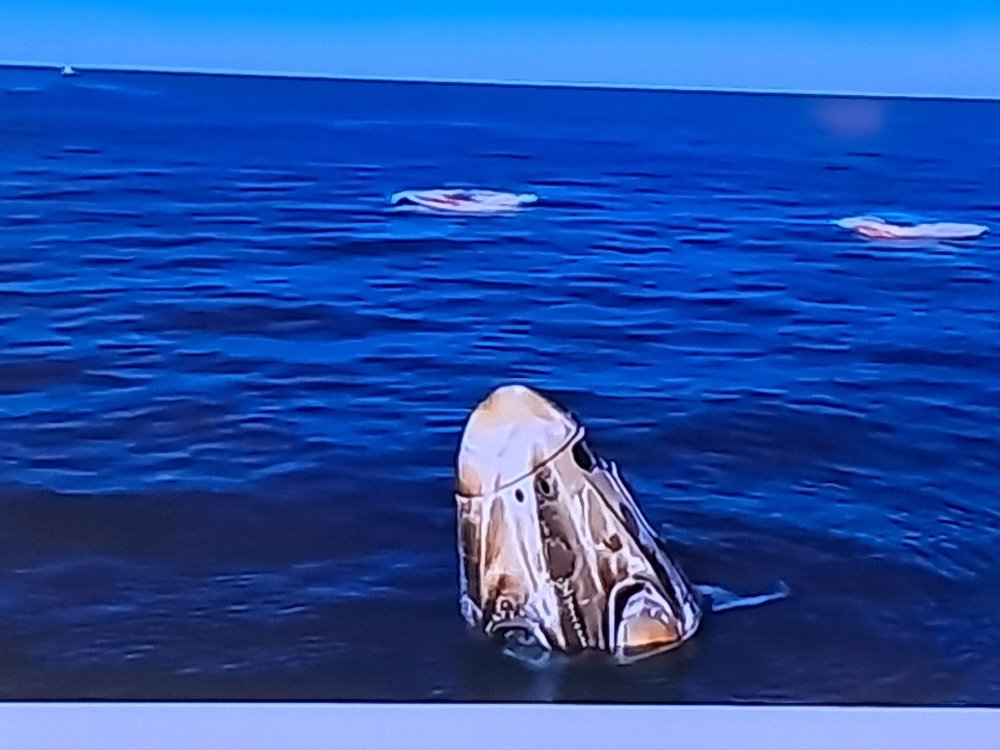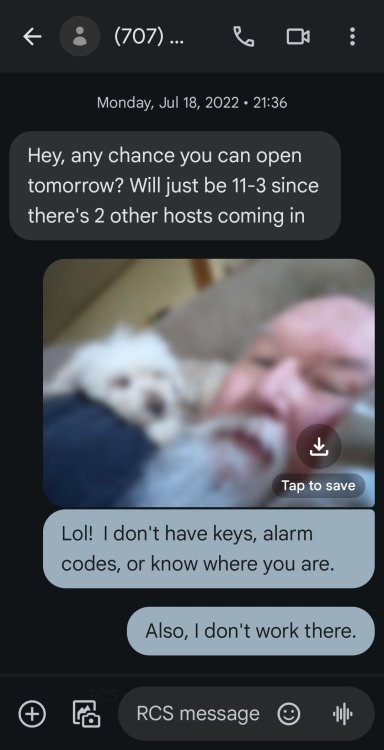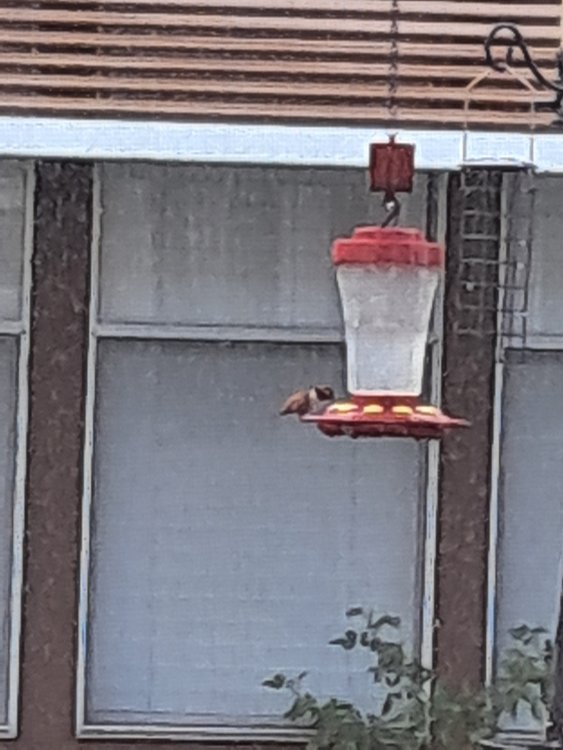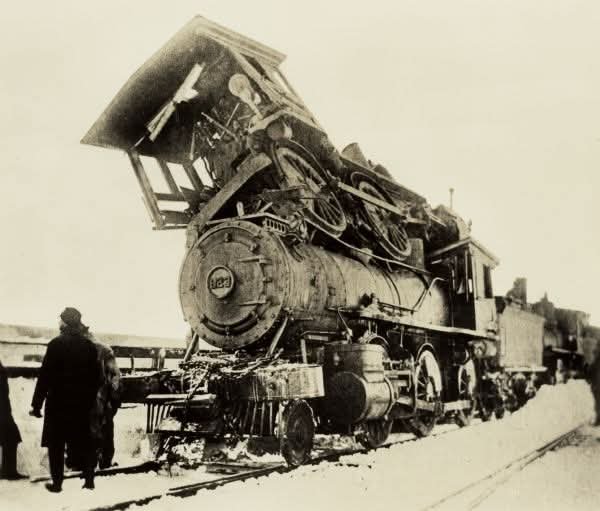-
Posts
53,399 -
Joined
-
Last visited
-
Days Won
631
Content Type
Profiles
Forums
Events
Everything posted by Subdeacon Joe
-
I'm sitting here giddy as a schoolboy watching the reentry, splash down, and recovery. About 5 minutes from splash to the small fast boats made it to Dragon. And another 5 for the recovery vessel to get there. The memories of the long waits, aircraft carrier divisions, helicopters with swimmers jumping out of them flooding back. The sense of awe, wonder, amazement, and joy are never going to go away. In fact, seem even greater now because of the comparisons I'm able to make. OOOOoooo.. DOLPHINS playing maybe 20 yards from Dragon! How COOL! WHAT A MARVELOUS TIME TO BE ALIVE!
-
Just click through it.
-
-
Mains deployed! GORGEOUS! Splash down. Main chutes released.
-
https://www.mainememory.net/record/80891 https://commons.wikimedia.org/wiki/File:O%26W_Snow_Plow_3.jpg https://www.alamy.com/snow-plow-and-alberta-railway-and-irrigation-company-engines-22-and-image69148018.html
-
-
If we are going to get into texts, a couple of years ago my cell number got spread around some sort of eatery/bar in Healdsburg CAax the numberof one of the girls working there. For about 2 months I would get at least once a week a text asking her to cover for someone who couldn't make it in. I always replied so the sender knew that the person wasn't ignoring the texts. Got some nice banter going on.
-
I've got to try making these eggs. https://youtu.be/s5ue-cMv-Ng?si=11g1SG6BzJ4T4fGF https://www.instagram.com/reel/DHUBW0ptD0t/?igsh=MzRlODBiNWFlZA==
-
I like that the first time, although she initially turned around in embarrassment, she listened to the coach and pushed through.
-

The Photo thread of Photos that YOU took
Subdeacon Joe replied to Buckshot Bear's topic in SASS Wire Saloon
-
We used to get calls on our landline from Little Old Ladies intended for the handyman/maintenance man for what I assume is an assisted living facility. I'd usually call back and let them know that they had called the wrong number. I also used to get calls from the Sacramento Jail, all urgently needing to get in touch with someone about....danged if I can remember, court date? failure to check in?.....and as a courtesy I'd call back and let the caller know that they had called the wrong number, didn't want someone getting deeper in Dutch because the clerk had called the wrong number.
-
That would have been false advertising - it was increasing income but not holding down bills - and would be mail fraud. There was a similar story, an ad in the back of a tabloid or magazine, "For information send $5 and stamped, self addressed envelope to P.O Box ### " The guy sent people who responded a page from a dictionary. Someone filed a complaint alleging mail fraud. He beat it by pointing out that the information type wasn't specified and that the pages he sent did contain information.
-
Authentic!
-
22 years ago....coach helped her get through it Now, she tries again Well done.
-
Yep ... that's what the Spring Training games are for. I'd say "low key" rather than boring. Also the announcers aren't first string. But....IT'S BACK! First pitch Imanaga v. Ohtani in Tokyo.
-
The Almighty must have had something for him to do later.
-
- 3
-

-

-
OK, this site uses lots of profanity, but tells the story well: https://www.badassoftheweek.com/ben-l-salomon A less luring telling: https://www.nationalww2museum.org/war/articles/benjamin-salomons-medal-honor The Citation : could back to the regimental aid station, while he attempted to hold off the enemy until they were clear. Captain Salomon then grabbed a rifle from one of the wounded and rushed out of the tent. After four men were killed while manning a machine gun, Captain Salomon took control of it. When his body was later found, 98 dead enemy soldiers were piled in front of his position. Captain Salomon's extraordinary heroism and devotion to duty are in keeping with the highest traditions of military service and reflect great credit upon himself his unit and the United States Army.”
- 1 reply
-
- 3
-

-

-
As found on FB Talk about a train wreck? This photo will have you scratching your head and wondering how this could have ever happened! This peculiar wreck happened on the Northern Division of the N.Y., N.H. & H. Railroad near Worcester, Mass. On February 2, 1898. Sources say Engine 823, a 50-ton freight locomotive, was pushing a snowplow at a high rate of speed when it collided with Engine 684, an eight-wheel locomotive of lighter weight, which was also running at a high speed, and pulling a milk train. Five men who were in the snowplow jumped into a bank of snow and were uninjured. Another strange feature of this peculiar wreck is that just previous to the collision the men in the snowplow discovered that the knob was off the door, and they were locked in. They finally contrived to open the door, and on looking out saw the milk train coming. The snowplow was demolished. Do you wonder how this could have happened? Sources say the wreck was caused by a telegraph operator going to sleep and allowing the snowplow to pass his station when he had orders to hold it. Source: Information found by Angela Richardson, Nov. 2014: From Locomotive Firemen’s Magazine, March 1898 photo: WHI Image ID 78385
-
Kinda minimalist....might want to ad at least shirt, pants, and boots.
- 22 replies
-
- 14
-

-

-
https://en.wikipedia.org/wiki/The_Bahamas "The Bahama islands were inhabited by the Arawak and Lucayans, a branch of the Arawakan-speaking Taíno, for many centuries.[14] Christopher Columbus was the first European to see the islands, making his first landfall in the "New World" in 1492 when he landed on the island of San Salvador. Later, the Spanish shipped the native Lucayans to Hispaniola and enslaved them there, after which the Bahama islands were mostly deserted from 1513 until 1648, as nearly all native Bahamians had been forcibly removed for enslavement or had died of diseases which Europeans had brought with them from Europe. In 1649,[15] English colonists from Bermuda, known as the Eleutheran Adventurers, settled on the island of Eleuthera."
-
I tried it. It's not worth it. It's bland and has a weird texture. Stick with Hellmann's/Best Foods. If you want to try something different, try https://www.mccormick.com/spices-and-flavors/mayonnaise/mayonnaise-with-lime-juice
-
Plattdeutsch vs. Hochdeutsch.
-
I was listening to the morning news and heard the announcer say "Happy Saint Paddy's Day." Several things struck me, 1.) He said it right. So many say "St. Patty's Day." 2.) In Irish his name is Pádraig. 3.) In his native Welsh it's Pádrig In which case "Paddy" makes sense. But, 4.) In English we call him "Patrick" with a T , not Pádraig, with a D. In which case "Patty" makes more sense.
